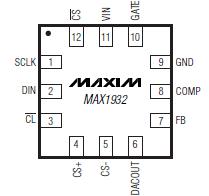Features: · Small Circuit Footprint
· Circuit Height < 2mm
· 2.7V to 5.5V Input
· 4.5V to 90V Output
· No Overshoot
· Accurate High-Side Current Limit
· Avalanche Indicator Flag
· 8-Bit SPI-Compatible DAC
· Compatible with External DAC
· 0.5% Accurate Output
· Low Ripple Output (< 1mV)
· Small 12-Pin, 4mm × 4mm Thin QFN PackageApplication·Optical Receivers and Modules
·Fiber Optic Network Equipment
·Telecom Equipment
·Laser Range Finders
·PIN Diode Bias SupplyPinout Specifications
SpecificationsVIN to GND...............................................................-0.3V to +6V
DIN, SCLK, CS, FB to GND ........................................-0.3V to +6V
COMP, DACOUT, GATE, CL to GND ................-0.3V to (VIN +0.3V)
CS+, CS- to GND ..................................................-0.3V to +110V
Continuous Power Dissipation (TA = +70°C)
12-Pin Thin QFN (derate 16.9mW/°C above +70°C) .1349mW
Operating Temperature Range .........................-40°C to +85°C
Junction Temperature......................................................+150°C
Storage Temperature Range ...........................-65°C to +150°C
Lead Temperature (soldering 10s) ..................................+300°C
Stresses beyond those listed under "Absolute Maximum Ratings" may cause permanent damage to the device. These are stress ratings only, and functional operation of the device at these or any other conditions beyond those indicated in the operational sections of the specifications is not implied. Exposure to absolute maximum rating conditions for extended periods may affect device reliability.
DescriptionThe MAX1932 generates a low-noise, high-voltage output to bias avalanche photodiodes (APDs) in optical receivers. Very low output ripple and noise is achieved by a constant-frequency, pulse-width modulated (PWM) boost topology combined with a unique architecture that maintains regulation with an optional RC or LC post filter inside its feedback loop. A precision reference and error amplifier maintain 0.5% output voltage accuracy.
The MAX1932 protects expensive APDs against adverse operating conditions while providing optimal bias.Traditional boost converters measure switch current for protection, whereas the MAX1932 integrates accurate high-side current limiting to protect APDs under avalanche conditions. A current-limit flag allows easy calibration of the APD operating point by indicating the precise point of avalanche breakdown. The MAX1932 control scheme prevents output overshoot and undershoot to provide safe APD operation without data loss.The output voltage can be accurately set with either external resistors, an internal 8-bit DAC, an external DAC, or other voltage source. Output span and offset are independently settable with external resistors. This optimizes the utilization of DAC resolution for applications that may require limited output voltage range, such as 4.5V to 15V, 4.5V to 45V, 20V to 60V, or 40V to 90V.

 MAX1932 Data Sheet
MAX1932 Data Sheet







